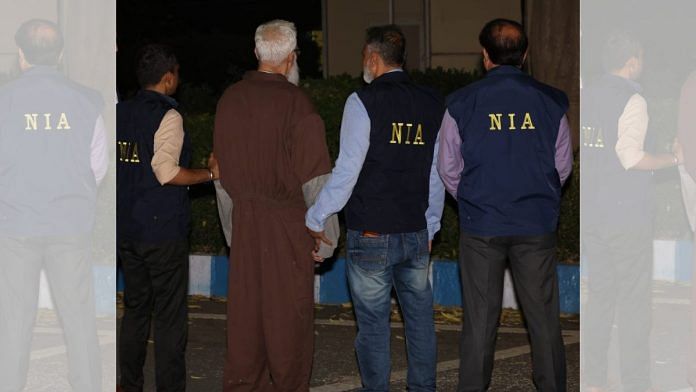The most important of the deportees is Ramanjit Singh ‘Romi’ from Hong Kong, who is accused of engineering the November 2016 jailbreak that led to the escape of Khalistan Liberation Force (KLF) chief Harminder Singh Mintu. Though Harminder Singh was rearrested within hours, Ramanjit is alleged to have carried out multiple armed robberies in Hong Kong before his arrest there.
Khalistan terrorism, the data shows, isn’t a significant force in Punjab: Since 2000, the state has registered single-digit terrorism-related annual fatalities in all years but two. In most years, no persons have been killed. “No sudden eruption is visible in these trends,” counter-insurgency expert Ajai Sahni has dryly pointed out, “though a motivated eruption in the social media as well as on certain ‘mainstream’ media channels is visible in the wake of every single incident.”
The eruption that is actually going on—in and outside Punjab—is getting dangerously little attention.
Tangled threads
The strange story of Radiowalla, documented in United States court records, helps understand just why Indian authorities have struggled to secure deportations and extraditions: The evidence is often murky, and prosecutions botched. For several years, Radiowalla told an immigration tribunal in the US that he worked as an auto-rickshaw driver for the Mumbai gangster Hussain Vastra. Later, however, leaks of information on the operation of the Dawood Ibrahim crime cartel were traced to Vastra. Vastra—wisely—blamed his driver, claiming Radiowalla was the snitch.
As it happened, Radiowalla admitted that this was true. Legendary Mumbai police officer Vijay Salaskar, who was killed on 26/11, paid him Rs 2,000-6,000 for each bit of information, depending on whether it pertained to future extortion attempts or the planning of homicides.
Lacking any legal framework or resources to protect his witness, Salaskar obtained a passport for Radiowalla and advised him to become an illegal immigrant in New Jersey. For months, Radiowalla struggled to support a family of four on $300 a week. Then, the doors to his immigrant dreams opened, with his cosmetics business registering gross profits of between $120,000 to $225,000 a year. Three of his children began attending college, and a fourth was in high school.
For reasons that aren’t entirely clear, though, the Mumbai police began suspecting that Radiowalla was laundering funds extorted by gangs from the city’s music industry. There was no evidence of criminal wrongdoing in the US, but judges eventually held that Radiowalla’s wrongful entry was enough reason to deport him.
Twelve men, including Radiowalla, were charged by prosecutors with organising a drive-by shooting at film producer Karim Morani’s home in Khar. In 2021, a prosecution witness claimed that Radiowalla engineered the attack to coerce Morani to sell the overseas film rights to alleged gangster Ravi Pujari. All twelve suspects, though, were acquitted for want of evidence. Radiowalla remained in prison, on other charges.
Large numbers of other cases have gone the same way. Earlier this year, the Punjab and Haryana High Court acquitted Jagtar Singh, who police claimed to have arrested when he was plotting armed robbery in Faridkot. The gun the police recovered from him, it emerged during trial, had no firing pin, making it incapable of use.
In another recent case, Sukhpreet Singh Budha and Dilpreet Singh Baba were acquitted because of a lack of evidence. In December 2024, Dilpreet and his associate Sukhpreet were alleged to have attempted to extort money from the singer Rupinder ‘Gippy’ Grewal. On 14 April 2018, Grewal was reportedly shot and injured in an attack after refusing to pay extortion money.
Following an international hunt, authorities in Armenia located and deported the two men. The court’s judgment means India has little to show for its efforts.
And earlier this year, a court in Punjab acquitted Jagtar Singh Johal, a resident of the United Kingdom arrested with the assistance of MI6 in 2017, on charges related to his alleged membership of the KLF. Eight other cases remain pending, even though serious doubts have been raised about the quality of evidence presented by the Punjab police.
Even as police forces flail in their war against alleged Khalistan terror, the real problem isn’t being addressed.
Also read: Saudi Arabia is looking beyond oil to engage with India. Green energy to AI
Firing without target
Little imagination is needed to see that the ideological cause of Khalistan has given way to an inchoate youth anomie—an anomie expressed through the gangster hip-hop, suffused with images of guns and unattainable women. The songs of the assassinated Moosewala and his contemporaries, scholar Connor Singh VanderBeek astutely observes, have fused the conventions of hip-hop with “Punjabi masculinist conventions, giving downtrodden Jatts a new outlet for coming to terms with their disempowerment.”
From a dominant caste, the Jatt now inhabits a world where land is no longer power, nor social deference automatic. “The anxieties of displacement ring in lyrics that boast that you do not cross a Jatt, even if that Jatt is now working low-level, menial jobs,” VanderBeek observes.
Like so many in the gang world, Moosewala was born into a southern Punjab where the cotton crop was in crisis. Farmers were hard-hit by the need for massive pesticide use and large-scale indebtedness, often to finance social obligations their family income could no longer sustain. The state’s failure to imagine industrial and market policies that could engage this youth cohort created the conditions for Moosewala’s music and many other performers like him.
This culture of gangsterism—often forged in universities, among peer groups—is sustained by low-level narcotics trading. Even though Punjab has a grim reputation for drug use, evidence suggests that narcotics use is nowhere near as widespread as claimed. The 2015 Punjab Opioid Dependence Survey put the state’s “opioid dependent population” at an estimated 0.81 per cent of 28.6 million people.
Nevertheless, alcoholism and drug use remain real problems among young people. And the state has made few investments in services that might draw this vulnerable cohort off the streets, and into sport, education, or rehabilitation.
These forces have replicated themselves in the diaspora, particularly Canada, where gangs offer a stage for agency and masculinity that new immigrants do not otherwise enjoy. Even though the ethnic-Punjabi diaspora accounts for just about 2.6 per cent of the country’s population, some 21 per cent of gangsters killed in gang wars or police operations since 2006 were members of the community. Ethnic-Punjabi gangs are increasingly competing with Latin American and Asian cartels. Earlier this year, US prosecutors revealed charges against six ethnic-Punjabi men, both Indian and Canadian, for bringing cocaine for distribution in New York.
Also read: Trump only offers chaos, not clarity. A 90-day tariff pause won’t fix strategic stupidity
The real enemy
Even though India’s intelligence and police services have been relentlessly focused on Khalistan agitprop, the threat posed by organised crime is far deeper and more consequential. For one, it points to deep social fractures that the political system and civil society are failing to address. Two, it demonstrates the existence of a large sphere of economic activity outside the state system—sand mining, public-works contracts, extortion, and protection rackets for liquor vends—which feed gangsterism.
As police officer VS Deuskar noted in a seminal study, the largest single force that enables gangsterism is public demand for illegal goods and services—a demand often created by dysfunctional legal and bureaucratic systems.
Finally, the inability of the criminal justice system to reliably prosecute and convict key gang members breeds contempt for the law. From 2018 to 2023, Punjab government figures show, the police made over 85,000 arrests related to the possession of narcotics. The stand-out consequence has been the creation of a large pool for gang recruitment in prisons.
The real threat to India isn’t from Khalistan agitprop at Gurudwaras in Brampton. The danger is in plain sight, just a short drive from Delhi, in a land where the nation-state is at risk of imploding, and a people, of losing their way.
Praveen Swami is contributing editor at ThePrint. His X handle is @praveenswami. Views are personal.
(Edited by Prasanna Bachchhav)
var ytflag = 0;
var myListener = function() {
document.removeEventListener(‘mousemove’, myListener, false);
lazyloadmyframes();
};
document.addEventListener(‘mousemove’, myListener, false);
window.addEventListener(‘scroll’, function() {
if (ytflag == 0) {
lazyloadmyframes();
ytflag = 1;
}
});
function lazyloadmyframes() {
var ytv = document.getElementsByClassName(“klazyiframe”);
for (var i = 0; i < ytv.length; i++) {
ytv[i].src = ytv[i].getAttribute('data-src');
}
}








